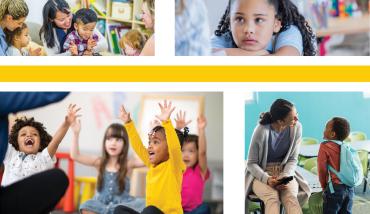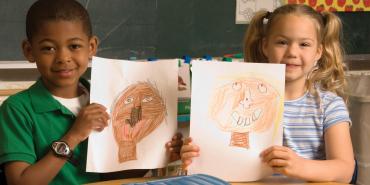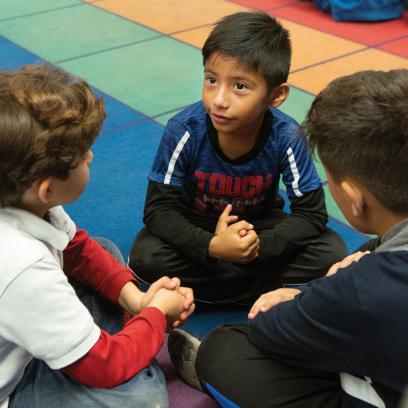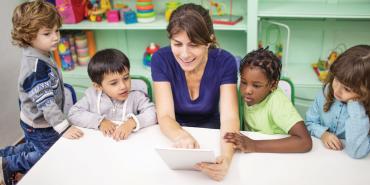Anti-bias education is an optimistic commitment to supporting children who live in a highly diverse and yet still inequitable world. Rather than a formula for a particular curriculum, it is an underpinning perspective and framework that permeates everything in early childhood education—including your interactions with children, families, and colleagues. Anti-bias education developed from the need to identify and prevent, as much as possible, the harmful emotional and psychological impacts on children from societal prejudice and bias. Its four core goals reflect research about these negative influences.
Goal 1, Identity
- Teachers will nurture each child’s construction of knowledgeable and confident personal and social identities.
- Children will demonstrate self-awareness, confidence, family pride, and positive social identities.
Goal 2, Diversity
- Teachers will promote each child’s comfortable, empathic interaction with people from diverse backgrounds.
- Children will express comfort and joy with human diversity, use accurate language for human differences, and form deep, caring connections across all dimensions of human diversity.
Goal 3, Justice
- Teachers will foster each child’s capacity to critically identify bias and will nurture each child’s empathy for the hurt bias causes.
- Children will increasingly recognize unfairness (injustice), have language to describe unfairness, and understand that unfairness hurts.
Goal 4, Activism
- Teachers will cultivate each child’s ability and confidence to stand up for oneself and for others in the face of bias.
- Children will demonstrate a sense of empowerment and the skills to act, with others or alone, against prejudice and/or discriminatory actions.
More specifically, applying the four anti-bias education core goals to racialized identity includes:
- Children will feel positive, but not superior or inferior, about their racialized identities. They will understand that their skin color or eye shape or hair texture does not determine their value as human beings.
- Children will have accurate words and information about each other’s different racialized identities. They will also appreciate their shared humanity and how they are like each other.
- Children will develop beginning skills for identifying and questioning misinformation, stereotypical ideas and images, and hurtful behaviors directed at their own and others’ racialized identities. They will know that it is not fair to treat people hurtfully because of who they are.
- Children will demonstrate beginning skills for interrupting biased behaviors targeted at their own and others’ racialized identities and for creating a fair classroom environment.
Awareness and Curiosity
Young children are aware of and curious about people’s features related to what society calls race. Eye shape, skin color, and hair fascinate children and are the first aspects of racialized social identity that they notice. By age 4, children begin to pick up on social identity terms for their own and other groups, which can be quite puzzling for them. They also begin to pick up misinformation, stereotypes, and negative attitudes about themselves and others. Here are three examples of young children grappling with these ideas:
“How do people get their color?” asks 3-and-a-half-year-old Thomas, who is white.
* * *
“I’m not Black. I’m African American,” Ebonie, 4 years old, says earnestly to her teacher.
* * *
Rosalie, a 5-year-old Puerto Rican girl, is reluctant to move out of the shaded areas of the play yard. She explains to her teacher, “If I get sun on my skin, it will get darker. My family says I’m dark enough already.”
Biologically, there is no such thing as race. All people are members of one race, Homo sapiens, the human race—even though everyone does not look the same. However, in a society where systemic racism exists, everyone has a racialized identity, an identity that holds power in the life of each person. All children grow up surrounded by and absorbing the socially prevailing positive and negative messages about themselves and others, which come from media; from educational, religious, and legal institutions; and from the behavior and beliefs of the important adults in their lives.
No one has the individual choice to opt out of socially assigned racialized identities. But each person has a choice about how to live with them. People have the capacity for acquiring new knowledge and feelings about their own social identities as well as the social identities of other individuals. Members of the white racial group can choose to believe in the myths of superiority that justify advantages and privileges to their group. Or they can reject those myths and work to end the system of racism that creates these dynamics. Members of groups targeted by racism can live as if the myths of inferiority are true descriptions of themselves. Or they can reject those damaging notions and work against the ideas and structures that create social disadvantage for them.
Some people think that if no one noticed or spoke about differences in skin color, racialized social identities and racism would disappear. However, that isn’t the answer. Pretending not to notice differences devalues the real-life experiences of people of color and ignores the reality of white advantages. Anti-bias education rests on the premise that, as long as racism continues to exist, everyone—children, families, teachers, community members—absorbs society’s messages about racialized social identity groups. But—and this is a big but—anti-bias educators can learn to clean their lenses to see with a more accurate eye and mind and a caring heart.
Intersectionality of Race and Class
Systemic racism continues to powerfully affect the lives of children and their families. According to the National Center for Children in Poverty (NCCP), children of color are still more likely to experience adverse societal conditions than white children. “Poverty is the single biggest threat to children’s healthy development.”1 NCCP’s analysis of 2016 statistics illustrates how the relationship between families living with low income (below 200 percent of the federal poverty threshold) or in poverty (below 100 percent of the federal poverty threshold) varies by race and ethnicity. While some young children of all racial backgrounds live in low-income, poor, or deep poverty (less than 50 percent of the federal poverty threshold) families, the data reveal the impact of institutional racism on economics.2
In 2016, 13 percent of white children lived in poor families and 6 percent lived in deep poverty.3 Thirty-seven percent of African American children’s families were in the poor category and 19 percent in deep poverty. In addition, 30 percent of Latinx young children’s families lived in poverty and 13 percent in deep poverty. Among Native American children’s families, 39 percent were living in poverty and 19 percent in deep poverty. These systemic economic facts tell us that white children and families are still more likely to have access to resources that support healthy development and future success than are children and families of color. Risks are greatest for children who experience poverty when they are young or experience deep, persistent poverty.4
Incarceration of a family member is another developmental stressor that reflects the systemic racism in the lives of children of color. The Annie E. Casey Foundation looked more closely at the 5 million children with a parent in jail or prison at some point in their lives. African American and Latinx children are over seven times more likely than their white peers to have a parent who is incarcerated. This situation exists for several reasons, including racial profiling, lack of money for bail, and longer prison sentences. “More than 15 percent of children with parents in federal prison—and more than 20 percent with parents in state prison—are 4 or younger.”5 The incarceration of a parent has a great impact on a child’s well-being.
There is research evidence that high-quality early childhood education programs can play a valuable role in countering the traumatic effects of poverty and racism. One world-renowned longitudinal study explored the outcomes of the Ypsilanti Perry Preschool Project (1962–1967), an experimental high-quality preschool program for African American children living in poverty in a small Michigan city.* The HighScope Educational Research Foundation documented the lives of the children attending the preschool program and followed them until midlife.6 A control group of children with similar demographics but no preschool experience was also followed. The Center for the Economics of Human Development, at the University of Chicago, then carried out further assessments when the children were in their mid-50s.7
These studies found that children participating in the Perry Preschool Project had important lifelong gains in education (completing high school and, for a few, college), in employment, and in personal life outcomes. All of these outcomes were significantly better than those of the children in the control group. Of equal importance, the next generation, the children of the Perry Preschool participants, also showed significant gains in education, health, employment, and civic life.
Young Children Construct Ideas and Attitudes About Racialized Identities
From infancy on, children absorb messages about the construct of race from a range of sources—family, teachers, media, peers, books, and social, political, and religious institutions. From these messages, they gradually form an internalized racialized identity. Thus, everyone’s racialized identity is imposed from the outside and constructed from the inside.
This process is based on three dynamics. One is how the society into which children are born defines racial groups and assigns racialized identities. These definitions are often codified in law and then disseminated through a range of sources. A second dynamic is children’s life experiences, particularly how children are valued and treated by the significant people in their lives, such as family and teachers. The third dynamic is how individual children come to think and feel about who they are, a process that continues throughout life.
Research studies exploring young children’s awareness and attitudes about racialized identities seriously began in the 1950s.8 This body of research contradicts the mistaken belief that young children do not notice or show interest in features connected to racial group membership, particularly skin color. Even infants and toddlers begin to notice and show curiosity about differences in skin color.9 By the time children are 3 and 4 years old, they become aware of value judgments and feelings related to various racialized identities and begin to act on negative feelings about others that they absorb.10
Diversity does not cause prejudice, nor does children noticing and talking about differences, as some adults fear. Children learn prejudice from messages and images of prejudice. They also learn from the silence or discomfort of adults when children ask or comment about the human differences they see around them.
In contrast, when you actively pay attention to children’s developing ideas and feelings about their own and others’ racialized identities, you foster their ability to gain accurate knowledge and develop self-esteem. Interacting with children about their developing ideas and feelings also counters misinformation, unease, or hurtful ideas about members of various racialized groups. By breaking the silence, you and the children’s families can nurture their accurate knowledge, empathy, enjoyment, and anti-bias relationships with racially diverse people.
Contrary to what some people assume, white children—as well as children of color—also develop a racialized identity. White children continually receive messages from families, communities, and media about white normalcy, superiority, and entitlement and construct their ideas about being white in the context of systemic, cultural, and individual racism.11 Very early, white children come to value their whiteness, presume it is the definition of normal, and believe that therefore all other skin colors are strange and less than.12 While early childhood teachers want all children to like who they are, the challenge for an anti-bias educator is to enable white children to like who they are without developing a sense of white superiority.
One of the pioneers in the study of how young children develop identity and prejudice, Kenneth Clark, noted many years ago the ways racism also harms white children’s development. He describes how growing up with the societal contradiction between the professed goals of equality and democracy and the pressures to violate them by acting on racial prejudice can create moral conflicts and guilt for white children. He also warned that white children “are being given a distorted perception of reality and of themselves and are being taught to gain personal status in unrealistic ways.”13
The social-political and psychological dimensions of race and racism remain a contentious and painful issue in society. If early childhood educators want children to thrive in a diverse world, they must commit to helping them make sense of the confusing and often emotionally charged messages they receive about their own and other people’s racialized identities.
Give children language to discuss their identities, and answer their questions in an atmosphere of interest, delight, and accurate information. Plant seeds of openness and connection. Teach them tools for addressing the unfairness they will inevitably encounter, and encourage them to stand up for themselves and others. You can help children construct a strong foundation for thriving in a diverse world now and into the future.
Louise Derman-Sparks has been an anti-bias education teacher of children and adults, author, and national and international consultant. Julie Olsen Edwards has been a family childcare provider, teacher, center director, teacher educator, writer, and advocate for children, families, and teachers. Catherine M. Goins is an early childhood education administrator, diversity educator, and college instructor. This article is adapted with permission from their book, Anti-Bias Education for Young Children & Ourselves, Second Edition (Washington, DC: National Association for the Education of Young Children, 2020).
*Louise Derman-Sparks (the first author of this article) was one of the Perry Preschool teachers. For her account of the educational program she and her colleagues developed, see here. (return to article)
Endnotes
1. National Center for Children in Poverty, “About NCCP,” 2020, nccp.org/about.
2. H. Koball and Y. Jiang, Basic Facts About Low-Income Children: Children Under 18 Years, 2016, Fact Sheet (New York: National Center for Children in Poverty, 2018).
3. Koball and Jiang, Basic Facts.
4. S. Smith, M. R. Granja, and U. S. Nguyen, New York State Profile of Young Children in Deep Poverty (New York: National Center for Children in Poverty, Mailman School of Public Health, Columbia University, 2017).
5. Annie E. Casey Foundation, A Shared Sentence: The Devastating Toll of Parental Incarceration on Kids, Families and Communities, Policy Report (2016), 2.
6. L. J. Schweinhart, H. V. Barnes, and D. P. Weikart, Significant Benefits: The High/Scope Perry Preschool Study Through Age 27 (Ypsilanti, MI: High/Scope Press, 1993); L. J. Schweinhart et al., Lifetime Effects: The High/Scope Perry Preschool Study Through Age 40 (Ypsilanti, MI: High/Scope Press, 2005); and D. P. Weikart, Longitudinal Results of the Ypsilanti Perry Preschool Project (Ypsilanti, MI: High/Scope Educational Research Foundation, 1993).
7. J. Heckman and G. Karapakula, The Perry Preschoolers at Late Midlife: A Study in Design-Specific Inference (Cambridge, MA: National Bureau of Economic Research, 2019).
8. K. B. Clark, Prejudice and Your Child (Boston: Beacon Press, 1963); M. E. Goodman, Race Awareness in Young Children (Cambridge, MA: Addison-Wesley, 1952); and H. Trager and M. R. Yarrow, They Learn What They Live: Prejudice in Young Children, Problems of Race and Culture in American Education, Issue 8 (New York: Harper & Brothers, 1952).
9. P. Bronson and A. Merryman, “See Baby Discriminate,” Newsweek, September 14, 2009, 53–59.
10. J. Lane, Young Children and Racial Justice (London: National Children’s Bureau, 2008).
11. L. Derman-Sparks and P. Ramsey, with J. O. Edwards, What If All the Kids Are White? Anti-Bias Multicultural Education with Young Children and Families, 2nd ed. (New York: Teachers College Press, 2011).
12. Derman-Sparks and Ramsey, What If?
13. Clark, Prejudice and Your Child, 81.
[photos by Getty Images; Allison Shelley for American Education: Images of Teachers and Students in Action]




